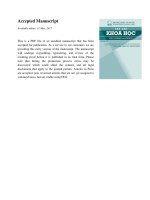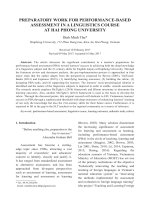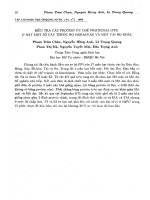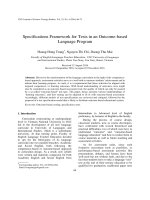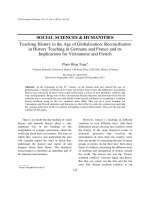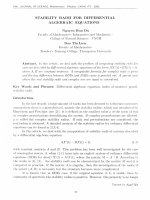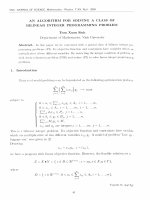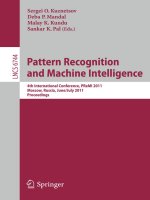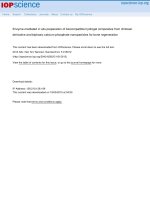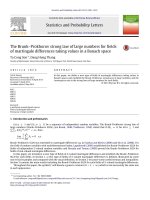DSpace at VNU: Computational Characterization for Catalytic Activities of Human CD38''s Wild Type, E226 and E146 Mutants
Bạn đang xem bản rút gọn của tài liệu. Xem và tải ngay bản đầy đủ của tài liệu tại đây (1.02 MB, 12 trang )
Interdiscip Sci Comput Life Sci (2010) 2: 193–204
DOI: 10.1007/s12539-010-0091-0
Computational Characterization for Catalytic Activities of Human
CD38’s Wild Type, E226 and E146 Mutants
My H. NGUYEN1 , Van U. DANG1,2∗ , Boi V. LUU1
1
(Faculty of Chemistry, Hanoi University of Natural Science, VNU, 19 Le Thanh Tong, Hanoi, Vietnam)
2
(Hoa Binh University, CC2, My Dinh II, Tu Liem, Hanoi, Vietnam)
Received 15 December / Revised 26 February 2010 / Accepted 4 March 2010
Abstract: A series of the complexes of human CD38’s wild type, E226 and E146 mutants as well have been
simulated. The biosoftwares well simulate the penetration of nicotinamide-adenine-dinucleotide (NAD) into the
active site. The nicotinamide end of NAD penetrates deep into the active site consistent with cleavage of the
nicotinamide-glycosidic bond which is the first step of catalysis creating a Michaelis complex regarded as the
intermediate product of NAD cyclase and hydrolysis reaction. The breaking down hydrogen bond between 2’-3’
OH ribosyl and the residues replaced Glu226 makes NAD to be less constrained in active site and nicotinamide
(NA) becomes more difficult to be cleaved and eliminates the mutant catalytic activities. The large majority of
the substrate NAD is hydrolyzed to ADPR while the conversion of NAD to cADPR is not the dominant reaction
catalyzed by wild-type human CD38. The more strongly kept ribosyl group by hydrogen bonds the more NADase
and the less cyclase activity. Breaking hydrogen bonds of ribosyl 2’- and 3’-OH by mutation will loosen it to
promote the cyclase. The cyclic adenosine diphosphate-ribose (cADPR) could also penetrate deeply into active
site to make some hydrogen bonds with Glu146 and Glu226 ; however, its docking poses are affected by a residue
located at the entrance of the catalytic pocket (Lys129 ). These results are in good agreement with the previous
crystallographic analysis and the experiments quantified the catalytic activities of human CD38 and its mutants.
Key words: human CD38, mutant, nicotinamide-adenine-dinucleotide, cyclase, hydrolysis reaction.
1 Introduction
A fundamental postulate in the classical drug design
paradigm is that the effect of a drug in the human
body is a consequence of the molecular recognition between a ligand (the drug) and a macromolecule (the
target). The pharmacological activity of the ligand at
its site of action is ultimately due to the spatial arrangement and electronic nature of its atoms, and the
way these atoms interact with the biological counterpart (Bohm et al., 1996). Computational chemistry
tools allow one to characterize the structure, dynamics, and energetic of the interactions between the ligand and a macromolecule as protein and DNA. For instance, molecular mechanics (MM)-based approaches
can efficiently assist the discovery of new drug candidates, and these computationally inexpensive methods
are nowadays routinely used in drug design (Jorgensen,
2004). However, if a description of the electronic properties is deemed necessary, there is no substitute for
quantum mechanics (QM). Indeed, since QM based ap∗
Corresponding author.
E-mail:
proaches also account for quantum electronic effects,
they describe bonds forming/breaking, polarization effects, charge transfer, etc., and usually estimate molecular energies more accurately (Sherwood, 2000; Jorgensen et al., 1988; Brooks et al., 1983). QM methods
are also fundamental to studying biological reactions, as
quantum electronic effects must be taken into account
to properly describe the phenomena of bonds forming/breaking. An excellent overview of target-related
applications of first principles quantum chemical methods in drug design is presented by Cavalli et al. (2006).
By various commercial and/or academic software’s
combining QM and MM based tools not only the
position and pose of ligands binding on protein but
also the inhibition constant as IC50 could be predicted in a rather agreement with spectroscopy experiments where IC50=10E bind /5.85, Ebind is binding
free energy between ligand and protein. These softwares make an ability to do predictive computations
of complicated biochemical processes. In this study,
we employed computational method softwares, namely
GLIDE (Schrodinger, 2000), QUANTUM 3.3 (Quantum Pharmaceuticals, 2007), WHAT IF (Gert Vriend
et al., 2009) and HYPERCHEM 8.0 (Hypercube, 2007)
194
to simulate the structure and energy of the enzymatic
domain of wild-type CD38 and its E226 and E146 mutants complexed with relevant ligands related to their
multitude of catalytic activities. The object ligand –
CD38 complexes are introduced briefly. Fortunately,
there are series of experimental study on structure and
activity of CD38 and its mutants are publicized and
atomic coordinates and structure factors have been deposited at the Protein Data Bank (PDB). These data
and a large amount of other ligand-protein complexes
deposited in PDB have been used to assess the computational procedure. The calculated results include
the cADPR hydrolase, NADase (NAD glycohydrolase)
– the intermediate Michaelis complex, the activation of
the intermediate Michaelis complex and E146 mutants’
cyclase and hydrolysis activity.
2 Ligand-protein complexes
CD38 was described first as an antigen that is involved in a host of lymphocyte functions including
differentiation, proliferation, and apoptosis (Malavasi
et al., 1994). Its expression has since been found to
be widespread among nonhematopoietic tissues as well
(Khoo and Chang, 1999). In addition to the antigenic functions, CD38 also possesses a multitude of enzymatic activities (Lee, 2006). It catalyzes not only
the hydrolysis of NAD and cADPR to ADPR, but also
the cyclization of NAD a long linear molecule, and its
analog, NGD, to produce a compact cyclic nucleotide,
cADPR and cGDPR, respectively. CD38 has also baseexchange activity that is responsible for synthesizing
NAADP from NADP.
The active site of human CD38 has been biochemically and structurally characterized (Munshi et al.,
2000; Liu et al., 2005). Glu226 is identified as the catalytic residue, because its mutation to other residues
essentially eliminates all its catalytic activities (Munshi et al., 2000). Ser193 is also important for catalysis
as its mutation to alanine also greatly reduces enzyme
activities (Liu et al., 2006). NAD will be conversed
to cADPR; however is not the dominant reaction catalyzed by wild-type human CD38. In fact, the large
majority of the substrate NAD is hydrolyzed to ADPR
(Howard et al., 1993). Completely the opposite is observed when NGD, an analog of NAD, is used as a
substrate. The dominant reaction is now cyclization
instead of hydrolysis, producing cGDPR as the major
product (Graeff et al., 1994). Considering the similarity
of NGD and NAD, which differ only in the purine rings,
it is puzzling why the reactions are so different (Liu et
al., 2007). Glu146 is a conserved residue present in the
active site of CD38. Its replacement with phenylalanine greatly enhanced the cyclization activity to a level
similar to that of the NAD hydrolysis activity. A series
of additional replacements was made at the Glu146 po-
Interdiscip Sci Comput Life Sci (2010) 2: 193–204
sition including alanine (E146A), asparagine (E146N),
glycine (E146G), aspartic acid (E146D), phenylalanine
(E146F) and leucine (E146L) (Graeff et al., 2001). All
the mutants exhibited enhanced cyclase activity to various degrees, whereas the hydrolysis activity was inhibited greatly. E146A showed the highest cyclase activity, which was more than 3-fold higher than its hydrolysis activity. All mutants also cyclized NGD to
produce cGDPR. This activity was enhanced likewise,
with E146A showing more than 9-fold higher activity
than the wild type. In addition to NAD, CD38 also hydrolyzed cADPR effectively, and this activity was correspondingly depressed in the mutants. When all the mutants were considered, the two cyclase activities and the
two hydrolase activities were correlated linearly. The
Glu146 replacements, however, only minimally affected
the base-exchange activity that is responsible for synthesizing NAADP (Graeff et al., 2001). Unfortunately,
E146-mutant’s structure has not yet been deposited in
Protein Data Bank. Homology modeling was used to
assess possible structural changes at the active site of
E146A (Graeff et al., 2001).
In this study, we employed the structures of the enzymatic domain of human CD38’s wild-type and its
mutants complexed with the relevant ligands, that is
NAD, ADPR, cADPR, NGD, GDPR, cGDPR, EPE,
NMN and N1C by x-ray crystallography (Howard et
al., 1993; Graeff et al., 1994; Munshi et al., 2000; Graeff et al., 2001; Liu et al., 2005; Liu et al., 2006; Liu
et al., 2007). The mutants investigated computationally in this study are E146A, E146N, E146G, E146L,
E146D, E146F and E146K, E146Q. Two latters were
obtained by replacing Glu146 by lysine (K) and glutamine (Q), respectively. The complexes provided a
step-by-step description of the catalytic processes involved in the synthesis and hydrolysis of cADPR. The
E226G – a mutant of CD38 received by replacement of
Glu226 by glycine – complexed with NMN – a substrate
of CD38 (code in PDB is 2hct), the complex of E226Q
mutant of CD38 and cADPR (code 2o3q), the complex E226D-cADPR (code 2o3r), E226G-cADPR (code
2o3s) and other ligand-protein complexes as well deposited on Protein Data Bank have been used to verify
the computational procedure.
3 Computational procedures
The calculation procedure includes three core algorithms: (i) the replacement of each residue in active
sites by other one then makes a geometrical optimization which simulates the site-directed mutagenesis technique; (ii) docking ligand on mutants to determine the
docking poses; (iii) calculating the binding energy of the
obtained complexes. Fortunately, all three algorithms
could be received on web in the form of source code, executive file and/or online calculation. Depending on the
Interdiscip Sci Comput Life Sci (2010) 2: 193–204
195
concrete algorithm the results received by these softwares may be different. Though there are many articles presented the studies on the reliability of various
bio –chemistry softwares applied to a large amount of
proteins of different kinds and shown the ability of each
software, this article pays attention to the software’s reliability applied to a narrow branch of proteins including the complexes between various ligands and CD38
and its mutants as well. Relating to the computational
characterization for the CD38’s multitude of catalytic
activities, we should choose the softwares could give
well prediction of the mutant structure based on native
protein structure – the site-directed mutagenesis - and
of the docking pose of ligand on active sites.
Mutant prediction – SWISS-PDB Viewer4.0 (Guex
and Peitsch, 2008) can be very useful to quickly evaluate the putative effect of a mutation before actually
doing the simulation work. CUPSAT (Parthiban et al.,
2006) gives also ability to predict the stability of the
mutant. WHAT IF gives on-line prediction of mutant
structure and comparison of a model to a resolved structure as well (Gert Vriend et al., 2009). We have also
used HYPERCHEM 8.0 (Hypercube, 2007) to make a
single residue replacement and optimize the mutant geometry. Table 1 presents the comparing results of some
CD38’s mutant models obtained by WHAT IF, SWISSPDB Viewer and HYPERCHEM to the solved structure
deposited in PDB of the relative mutant. All mutant
atom structure data are of in the form of mutant-ligand
complex with various ligands. Therefore, the ligands
have been discarded in comparing calculation.
The RMS on all atoms in all cases is about 1 ˚
A. In detail, WHAT IF gives rather smaller RMS and LD than
Table 1
RMS on all atoms of some mutant predicted models from solved structure deposited in Protein
Data Banka
CUPSAT
PDBb
Mutant
ΔΔG∗
Torsion favor
E226D
1.58
–
2o3r
E226G
1.64
–
2o3s
E226Q
a All
SWISS-PDB and HYPERCHEM. Taking into account
that with the exception of the mutated residue, energy
minimization procedure locked all rest residues and that
all residues of the predicted mutant are involved in RMS
calculation, the mutant predicted structures are in a
very good agreement with the experiment data. Using
HYPERCHEM and SWISS-PDBViewer softwares we
have also involved all residues in energy minimization
procedures. However, after very long CPU time the
obtained structure is not in a better agreement with
deposited structure than the previous predicted structure involving only one mutated residue in minimization procedure. It could be explained that, our calculations take into account the mutants created by single
site directed mutagenesis technique at active sites only.
Comparing the coordinate deposited in Protein Data
Bank of CD38’s wild type and its mutants at single
active sites gives RMSD of ∼1 ˚
A. It means that the
single residue replacement at active sites do not affect
obviously to the structure of protein with the exception
of mutated residue. The space made by active sites is
large enough in order to hold substitute residues being stable without large torsion unfavorable of the ligand and keep the other residues’ position unchanged
approximately. CUPSAT’s predicted stability data is
also presented in Table 1. However, E226Q should be
taken into account in software development for the long
chain and flexible residues. The conformation of mutation Gln226 received both by WHAT IF and SWISSPDB differentiates essentially with the crystallographic
one (Fig. 1(a)), while the mutation residues of a shorter
chain as Asp (Fig. 1(b)) and Gly (Fig. 1(c)) do not show
an obvious difference.
0.83
+
RMS2++
RMS1+
WHAT IF
HYPER
SWISS-PDB
0.955 1
0.953 6
0.968 5
0.971 2
0.955 2
0.955 2
1.176 3
1.058 9
2hct
1.017 3
1.011 0
1.016 4
1.016 4
2o3q
0.934 8
0.934 8
1.028 3
0.966 9
2o3t
0.998 6
0.991 2
1.134 2
1.079 4
2o3u
1.023 6
1.023 6
1.258 6
1.186 8
2pgl
1.056 5
1.049 8
1.219 4
1.214 7
RMS calculation were done on WHAT IF; b Deposited in Protein Data Bank discarded ligands; ∗ Predicted stability (kcal/mol);
with CD38 wild-type; ++ Comparing with solved structure in PDB.
+ Comparing
Docking – The ligand docking on CD38 and its mutants is predicted on QUANTUM 3.3 and GLIDE as
well. There are little differences between two softwares
in the preparation of the proteins and ligands. In both
cases we applied the rigid protein model and follow the
docking calculation procedure to receive model structure of the ligand-protein complex. The mutant – ligand complexes as: 2hct, 2o3q, 2o3r and 2o3s, 2o3t,
196
Fig. 1
Interdiscip Sci Comput Life Sci (2010) 2: 193–204
Illustration of the mutant prediction in active site. (a). Mutate prediction of E226Q (sticks) and the crystallographic
data of 2i65, 2pgl, 2o3q, 2o3u and 2o3t (lines); (b). Mutation prediction of E226D (sticks) and the crystallographic
data of 2o3r (lines); (c). Mutation prediction of E226G (sticks) and the crystallographic data of 2o3s and 1hct (lines).
All mutations received by WHAT IF on-line. All crystallographic data deposited on Protein Data Bank
2o3u, 2i65, 2pgl and wild-type CD38 – ligand complexes
as: 2pgj, 2ef1, 2i66 and 2i67 deposited in PDB were chosen to be testing samples of software reliability. As the
workspace structure consists of a receptor only, there is
no default center for the enclosing box. The box will
not be displayed until you have specified a grid center
by selecting residues or proposed ligand position. Surprisingly, the docking results depend essentially on the
position of grid center, especially in QUANTUM calculation of long chain and flexible ligands. In the cases
we are not sure of the proposed ligand position we may
select the center of the grid box by selecting any atom
that lies approximately in the middle of the active site
and all active site atoms that are on the surface of the
protein should be covered by a grid box, or at least all
important chemical groups of the active site should lie
inside the grid box. Perhaps a micro genetic algorithm
loop should be used to find the grid center giving the
pose of maximum binding free energy.
Among the output data of QUANTUM we can find
IC50 ((Mol/L), Ebind (kJ/mol) – the binding free energy including Ees (kJ/mol) – the electrostatic and solvation energy, Evdw (kJ/mol) – the short-range electrostatic and exchange and Van der Waals energies, TdS
(kJ/mol) – the entropy contribution, Etor (kJ/mol) –
the ligand internal energy change. We received also the
total charge Q, mass M, number of flexible bonds of the
ligand and RMSD (A) – the root mean square distance
between the initial and final position. In another way,
GLIDE gives GLIDE score includes standard precision
(SP) and extra precision (XP). GLIDE score is given
by:
Score = a∗ vdW + b∗ Coul + Lipo + Hbond + Metal
+Rewards+RotB+Site,
where vdW is van der Waals interaction energy, Coul is
Coulomb interaction energy, Lipo is lipophilic-contact
plus phobic-attractive term, HBond is hydrogenbonding term, Metal is metal-binding term (usually a
reward), Rewards is various reward or penalty terms,
RotB is penalty for freezing rotatable bonds, Site is polar interactions in the active site and a=0.063, b=0.120
for Standard Precision (SP) Glide 4.5.
In order to compare the reliability of the softwares
we used RMSD (˚
A) – the root mean square distance
between the solved position deposited in PDB and the
model position given by docking software. The calculation results are presented in Table 2. As most
docking softwares give some predicted docking sites of
the ligand Table 2 presented the RMSD and score of
two or occasionally three best ones. It is clearly that
GLIDE gives excellent results for cycle ligands and in
most cases gives RMSD lower than QUANTUM. In addition, both softwares give RMSD > 2.0 ˚
A for the complexes of CD38-wild type, especially, with NGD (code
2i66) where the active sites of both molecules were saturated with substrate NGD+ , and reaction proceeded
in the crystal. So that molecule B contains two nucleotides, a GDP-ribose intermediate and a hydrolyzed
product, GDPR, whereas molecule A contains GDPR
dimer (Liu et al., 2006). The docking calculation of only
one GDPR molecule would never give good agreement
with crystallographic data.
It should be noted that in some cases (the underline numbers in Table 2) the pose of smaller deviation
has lower score (GLIDE) or higher free energy (QUANTUM). Fig. 2 displays, for example, two highest score
docking poses of cADPR on E226Q mutant obtained
by QUANTUM. The complex has the accession code
of 2o3q at the Protein Data Bank. In most of these
cases the docking pose pairs of small binding free energy difference (∼2 KJ/mol for QUANTUM) or small
score difference (∼0.5 for GLIDE). It can be regarded
approximately as the indefiniteness of the docking data
given by the software in the cases of very large and extremely flexible ligands. Therefore, using QUANTUM
and GLIDE as well to predict the protein-ligand complex structures, it should be taken care the docking site
pairs of small binding free energy difference (QUAN-
Interdiscip Sci Comput Life Sci (2010) 2: 193–204
197
4 Results
TUM) or small score difference (GLIDE).
Table 2
Prediction results of docking ligands on
CD38 and its mutants
Protein Mutant Ligand
QUANTUM
RMSD+
2o3r
2o3s
2o3t
2pgj
E226D
E226G
CXR
CXR
E226Q CGR
1yh3
N1C
GLIDE(SP)
RMSD++
Gscore
0.319 8 −37.048 5
0.266 2
−8.75
6.124 7 −34.407 1
2.382 7
−8.60
6.188 5 −37.5786
0.248 6
−9.55
0.614 2 −36.730 4
0.577 1
−9.43
7.447 0 −34.216 9
0.158 9
−14.99
0.660 5 −33.903 3
0.387 4
−12.78
1.232 5 −34.673 2
0.225 1
−9.59
8.195 3 −30.854 6
8.091 1
−4.13
Ebind
2pgl
E226Q
N1C
1.291 0 −35.058 0
0.208 8
−11.76
8.600 5 −30.911 0
5.632 7
−2.94
2o3q
E226Q
CXR
6.026 1 −36.532 7
1.304 4
−6.22
0.326 4 −34.632 9
0.576 1
−5.49
−11.40
2hct
E226G NMN
0.684 2 −43.252 0
0.736 1
5.321 2 −32.191 6
1.053 3
−11.40
2o3u
E226Q NGD
1.343 8 −50.992 7
3.093 7
−10.15
4.793 2 −49.669 4
3.759 8
−9.95
1.252 3 −48.643 6
2ef1
2i65
EPE
1.244 7 −22.601 7
5.203 5
−3.81
3.681 6 −20.216 8
4.865 6
−3.69
E226Q NAD
0.958 5 −45.958 5
1yh3
In order to characterize the CD38’s catalytic activities we have predicted mutants by WHAT IF from
the atom coordinate crystallographic data of CD38’s
wild-type deposited in Protein Data Bank (code 1yh3).
Then, the docking poses of the various ligands are predicted by GLIDE and/or QUANTUM. The binding
free energy of the complexes between protein and ligand is calculated by QUANTUM. The reactions taken
into investigation are: cADPR hydrolase, NADase
(NAD glycohydrolase), ADP-ribosyl cyclase. The ligands involved in calculation are NAD, NGD, ADPR,
GDPR, cADPR, cGDPR, NA and NMN as well. NAD
and NGD are reactants; ADPR, GDPR, cADPR and
cGDPR are products in catalytic reaction. NA is coproduct of cyclising reaction and hydrolysis as well.
NMN is a substrate of CD38 (Liu et al., 2005) and is
also a mimic substrate of NAD and can be hydrolyzed
by CD38 (Sauve et al., 2000). As presented below, taking into account that there are indefiniteness of both
GLIDE and QUANTUM in the determination of docking pose of long chain and flexible ligands, not only one
but some highest score poses in each case should be
taken into account and the common tolerance of predicted binding free energies is accepted to be 15% as
defined by the authors of QUANTUM.
5 Discussion
2.424 8 −45.567 5
4.971 8
−9.04
8.600 5 −30.911 0
2.599 8
−8.96
3.238 5 −38.199 5
2.358 8
−7.66
2.181 0
−7.59
2i66
1yh3
G1R
1.291 0 −35.058 0
2i67
1yh3
APR
6.428 5 −37.983 0
+ Comparing
with the prepared ligand position;
with the initial ligand position.
Fig. 2
++ Comparing
Comparison of cADPR-ligand in two configuration
of largest binding free energy obtained by QUANTUM (sticks) and the poses deposited on Protein
Data Bank (lines). Being of smaller binding free
energy (−34.632 9 KJ/mol) (b) configuration is in
a much better agreement with PDB data than (a)
one of −36.532 7 KJ/mol
N ADase (N AD glycohydrolase) – the intermediate
Michaelis complex – By incubating preformed CD38
E226Q crystals with NAD+ Liu et al. (2006) found that
NAD+ can easily diffuse into the active site and form
the Michaelis complex. The linear NAD+ is constrained
by the enzyme and is stabilized in the active site by
extensive polar interaction involving residues Asp155 ,
Glu146 , Gln226 , Trp125 , Ser126 , Arg127 , and Thr221 and
a structural water molecule. The docking simulation of
the complex of E226Q and NAD gives a good agreement
with the 2i65 deposited in Protein Data Bank (Table 2.
RMSD=0.958 5). Taking into account that there is no
structural data of NAD complex with CD38’s wild-type
deposited on Protein Data Bank and the above calculation shown that the computational conformation of
mutate Gln226 residue is not in good agreement with
crystallographic data (see Fig. 1), in order to interpret
satisfactorily the single residue replacement effect on
the intermediate Michaelis complex we compare the
structure of NAD docked computationally on CD38’s
wild-type (code 1yh3) and on the complex 2i65 discarded the ligands (E226Q). The binding free energy
and its components are presented in Table 3 together
with the shortest atomic distances between NAD and
key residues.
198
Table 3
Mutants
E226Q
Interdiscip Sci Comput Life Sci (2010) 2: 193–204
(a) Binding free energy and its component
of NAD complexes
Ebind
Ees
Evdw
TdS
Etor
−51.458 6 −26.000 3 −61.921 1 −32.925 7
3.537 12
Wild-type −48.076 3 −17.095 9 −60.077 7 −32.914 5 −3.817 25
Table 3
Residue
GLU146
GLU226
GLY226
ASP226
(b) The shortest atomic distance between
NAD and some key residues
Residue atom
Distance(˚
A)
Mutant
Ligand atom
Wild
O
OE2
2.614 7
C
OE2
3.222 7
O
CD
3.616 6
E226G
O
OE2
2.886 6
E226D
O
OE2
2.587 6
O
CD
3.452 8
O
OE1
3.536 8
C
OE2
3.541 3
Wild
E226G
E226D
O
OE2
3.024 3
O
OE1
3.398 9
O
CD
3.605 5
O
CA
7.189 4
O
N
7.442 6
O
OD2
4.693 9
C
OD2
5.438 7
C
OD2
5.719 7
O
CG
5.722 0
The interpretation of catalytic activities based on
the degree of ligand penetration into the active sites
seems to be satisfactory. The Glu226 replacement by
glutamine (Q) seems not to affect significantly to the
docking pose of NAD (Fig. 3(a)). The nicotinamide
end of NAD also penetrates deep into the active site
consistent with cleavage of the nicotinamide-glycosidic
bond, which is the first step of catalysis. In order to
assess the effect of Glu226 replacement by glutamine we
compared the ligand-protein atomic shortest distances
obtained by docking software between CD38’s wild-type
and E226Q complex of NAD. It can be seen that NAD
could rather approaches to the Gln226 of E226Q than
the Glu226 of CD38’s wild-type (Fig. 3(b)). We calculated also the distribution of atomic distances in active
site (Fig. 4(a)). It can be seen that the Glu226 replacement by Gln226 brings NAD deeper to the active site
and seems to become more constrained and more stabilized by the residue replacement. It should be also
noted that there is no obvious computational evidence
for stretching the labile nicotinamide-ribosyl bonds in
NAD. The bond length of 1.483 ˚
A can be found in both
cases of CD38’wildtype and E226Q while the crystallographic data is 1.475 4 ˚
A in 2i65.
The computation well simulates the penetration of
NAD into the active site creating a Michaelis complex
which can be regarded as the intermediate product of
NAD cyclase and hydrolysis reaction. The activation of
the complex to promote the dissociation of the nicotinamide moiety from the substrate could not be observed by the docking software based on rigid bonds
model. Up to now, we have no computational evidence why Glu226 ’s mutation to other residues essentially eliminates all CD38’s catalytic activities as Munshi et al. obtained from experiments (Munshi et al.,
2000). However, the conformation of Gln226 in active
site obtained by WHAT IF and SWISS-PDB (Fig. 1(a))
could give us the answer. Docking NAD on the CD38’s
computational mutant E226Q gives another picture on
the active site. There is no hydrogen bond between
2’-3’ OH ribosyl with Gln226 (7.79 ˚
A) but with Glu146
only. So that, though NAD could also penetrate into
active site in the case of the mutant E226Q but it is less
constrained and stabilized than in wild-type. In fact,
there is a certain difference between complex structure
in crystal and in liquid. Unfortunately, we have no evidence that in aqueous solution Gln226 of CD38’s E226Q
mutant would take not crystallographic pose but computational pose. However, calculation shown that, in
CD38’s E226D and E226G there is also no hydrogen
bond between 2’-3’ OH ribosyl with Asp226 and Gly226 ,
respectively (Table 3(b)). So that we can affirm that
the breaking down hydrogen bonds between 2’-3’ OH
ribosyl and the residues replaced Glu226 makes NAD
to be less constrained in active site and NA becomes
more difficult to be cleaved and eliminates the mutant
catalytic activities.
The activated intermediate Michaelis complex – a
transition state – As intermediate Michaelis complex
reveals products with divergent conformation, the reaction coordinate of NAD cyclase and hydrolysis reaction
is not easy to define. We start the work by investigating the activation of the Michaelis complex. Following
the NAD docking poses received by calculation it can
be seen that the adenine terminus of NAD is out of the
active site and is not expected to be stabilized by the
enzyme (Liu et al., 2006) and contributes significantly
to the RMSD (see Fig. 3(b)). The nicotinamide end of
NAD penetrates deep into and becomes stabilized by
the active site. So that, the adenine end of NAD is
more flexible and is easy to leave.
In order to approach computationally the transition
state we used the so-called ‘fragment docking technique’
by cutting off the nicotinamide end and docking the
rest oxocarbenium ion intermediate of NAD and NGD
on the protein. The calculation result is presented in
Fig. 5(a) and Fig. 5(b) comparing the docking pose of
intermediate and ADPR in CD38’s wild-type. There is
no essential difference between the crystallographic and
computational docking poses of ADPR. Both crystallographic and computational distances between ribosyl
C-1’ carbon and the adenine ring N-1’ is, however, sur-
Interdiscip Sci Comput Life Sci (2010) 2: 193–204
199
Fig. 3
Stereo representation of NAD and active site. (a). Left: the NAD docking pose on E226Q (sticks) and the crystallographic data in 2i65 (lines); center: the NAD docking pose on CD38’s wild-type (sticks) and the crystallographic
data in 2i65 (lines); right: the NAD docking pose on CD38’s wild-type (sticks) and on E226Q (lines). (b). The active
sites (lines) and NAD docked on CD38’s wild-type (sticks-left) and on E226Q (sticks-right). There is no obvious
A) than
difference between two structures but the hydrogen bond length of ribosyl OH is shorter with Glu146 (2.6 ˚
A) in the former and is shorter with Gln226 (2.7 ˚
A) than with Glu146 (3.0 ˚
A) in the latter
with Glu226 (3.4 ˚
Fig. 4
(a) The intermolecular atomic distance population of NAD – active site residue. (b) Stereo representation of NAD
and active site in CD38’s computational E226Q mutant
prisingly much shorter (4.86 ˚
A) than the corresponding
distance in the intermediate complexes (9.30 ˚
A) and
the distance between ribosyl C-1’ carbon and guanine
ring N7 (8.65 ˚
A) as well (Fig. 5(d)) which shows experimentally the intermediate’s cyclase ability of CD38’s
wild-type. It means that, not the structure of intermediate but the molecular interaction between ligand and
active site is dominant in catalytic activities and it is
not clear that where will take place the intermediate
cyclization, inside or outside of the active site?
For the ADPR intermediate, the structurally conserved water molecules (crosses in Fig. 5(b)) not only
contributes to the stabilization of the products but also
attend to NAD hydrolyse either by the migration of
water molecule in hydrogen bonding with 2’-OH to ribosyl C-1’ or another water molecules attack ribosyl
200
Fig. 5
Interdiscip Sci Comput Life Sci (2010) 2: 193–204
Stereo presentation of docking poses. (a) ADPR’s (sticks) crystallographic pose in the active site residues (lines) of
A. The distance
CD38’s wild-type. The distance between ribosyl C-1’ carbon and the Glu226 hydroxyl group is > 10 ˚
between ribosyl C-1’ carbon and the adenine ring N-1’ is 4.86 ˚
A. (b) The computational pose of NAD oxocarbenium
ion intermediate (sticks) in the active site residues (lines) of CD38’s wild-type. The shortest distance between ribosyl
2’- or 3’-OH group and the residues Glu226 ’s carboxyl group is 2.95 ˚
A. The distance between structurally conserved
water molecule (cross) and another ribosyl –OH group is 2.42 ˚
A, between ribosyl C-1’ carbon and the adenine ring
N-1’ is 9.30 ˚
A. (c) and (d) Docking pose of NGD oxocarbenium ion intermediate in the complex crystal of CD38’s
wild-type. The distance between ribosyl C-1’ carbon and guanine ring N7 is 8.65 ˚
A. There are three hydrogen bonds
A) and Glu146 (3.62
between ribosyl 2’- or 3’-OH group and the carboxyl groups of residues Glu226 (3.22 and 3.19 ˚
˚
A)
C-1’. In the GDPR intermediate complex (Fig. 5(d)),
there are three hydrogen bonds would locate between
ribosyl 2’- or 3’-OH group and the carboxyl groups of
residues Glu226 (3.22 and 3.19 ˚
A) and Glu146 (3.62 ˚
A)
as well. So that, the hydrolyse can be completed in active site and the large majority of the substrate NAD
is hydrolyzed to ADPR while the conversion of NAD
to cADPR is not the dominant reaction catalyzed by
wild-type human CD38 as the outside adenine terminus of NAD may be more difficult to connect with the
ribosyl C-1’ located deeply and stabilized in actives site
though it is flexible.
Docked in the same active site GDPR intermediate gives a more favorable interaction energy condition
than ADPR (Fig. 5(d)) though the distance between
ribosyl C-1’ carbon and guanine ring N7 is large (8.65
˚
A).
Michaelis complexes intermediate in CD38’s E146
mutants and cyclase/hydrolyse activity – Graeff et al.
(2001) shown that the replacement of Glu146 by Phe,
Ala, Asn, Gly, Asp and Leu created the mutants exhibited enhanced cyclase activity to various degrees,
whereas the hydrolysis activity was inhibited greatly.
In order to continue study on the mechanistic understanding of human CD38-controlled multiple catalysis
the above calculation procedure has been applied to the
structure and activation of intermediate Michaelis complexes in E146 mutants and the prediction of the mutagenesis effect on the NADase and hydrolysis reaction
hoping that the analysis of the energy and structural
data of the intermediate could provide further insights
into the understanding mechanism of the catalytic reaction. The experimental data of the reaction activities
can be found in Graeff et al.’s article (2001).
Interdiscip Sci Comput Life Sci (2010) 2: 193–204
As the crystallographic structure of related mutants
and the complexes have not yet deposited on Protein
Data Bank we need predict, firstly, the mutants by
SWISS-PDBViewer and/or WHAT IF then dock NAD
and oxocarbennium ion intermediate as well on CD38’
E146 mutants. Taking into account that we have no
previous information on the ligand docking poses, in order to reduce the effect of grid center on docking results
we select the middle of the active site to be the center of
the grid box and all active site atoms should be covered
by a grid box. The active site of CD38’s wild-type and
mutants includes 10 residues Arg127 , Asp155 , Ser126 ,
Ser193 , Glu146 , Glu226 , Thr221 , Lys129 having extensive
polar interactions and Trp125 and Trp189 which are nonpolar but additionally the parallel displaced π − π interactions between its indol ring (Trp189 ) and the NAD
pyridine ring.
Table 4 presents NAD’s oxocarbenium ion intermediate (ADPRI) binding energy and its components on
CD38’s wild-type and its E146 mutants as well. Unfortunately, there is no obvious relationship between
Table 4
201
the catalytic activities and the computational energy
data and the distance between ribosyl C-1’ and adenine N-1’. However, the relationship between the C-1’N-1’ distance and cyclase/hydrolyse ratio can be regarded as linear approximately (Fig. 6). There are
essentially changes of intermediate’s docking pose because of Glu146 replacement. The hydrogen bonds are
also rearranged (Table 4) which is dominant for CD38’s
catalytic activities. Two extreme cases are CD38’s
wild-type and E146A. The former is stabilized strongly
by four hydrogen bonds between ribosyl 2’ and 3’-OH
group and Glu146 and Glu226 as well. The latter, however, has no hydrogen bond. It means that the more
strongly kept ribosyl group by hydrogen bonds the more
NADase and less cyclase activity. The hydrogen bonds
will prevent the ribosyl group penetrated into active
site to approach the N-1’ of adenine ring which located
flexibly outside. Breaking hydrogen bonds of ribosyl 2’
and 3’-OH will loosen it to promote the cyclase. It is
in a good agreement with Graeff et al.’s experimental
data (Graeff et al., 2001).
Oxocarbenium ion intermediate’s binding energy and its components on CD38’s wild-type and its
mutants (KJ/mol) and the distance of hydrogen bonds involving ribosyl 2’-3’OH (˚
A)
Mutants
Ebind
Ees
Evdw
TdS
Etor
E146A
−38.569 8
−6.435 6
−51.287 0
−25.233 3
E146D
−39.051 4
1.084 3
−54.211 0
−27.646 5
Hydrogen bond (˚
A)
Glu226
Other
−6.080 4
NA
NA$
−13.571 2
3.06/3.03
2.87∗
2.62∗
E146F
−39.058 0
−3.323 2
−51.911 0
−29.252 3
−13.076 1
2.69/3.11
E146G
−33.148 6
6.600 5
−49.164 6
−21.394 6
−11.979 0
NA
NA
E146L
−35.008 3
−1.756 0
−48.320 1
−22.788 3
−7.720 6
2.69/2.89
3.38∗
E146N
−37.790 9
0.631 4
−51.730 6
−28.486 6
−15.178 3
2.86/3.10
3.04∗
Wild-type
−36.931 0
−1.298 2
−49.785 2
−27.929 5
−13.777 2
2.95/3.36
2.69/3.87++
++ With
Glu146 ; ∗ With Trp125 ; $ Ignoring the bonds of > 4.0 A.
14
tion. Instead of hydrogen bonds with Glu146 in CD38’s
wild-type, four among six E146 mutants investigated,
that is E146D, E146F, E146L and E146N possess hydrogen bonds with Trp125 .
Distance (A)
12
10
8
6
4
Fig. 6
0
1
2
Cyclass/NADase
3
The computational distance between the ribosyl C-1’ and the adenine ring N-1’ versus cyclase/hydrolase ratio (Graeff et al.’s data)
The computational docking poses of the intermediate in active site of CD38’s wild-type and mutants also
show the collaborative role of Trp125 in catalytic reac-
cADPR hydrolase – To evaluate the structural basis of the hydrolysis of cADPR Liu et al. (2005) set
up a model cADPR into shCD38, the complex structures of CD157 with its substrate analog Etheno-NADP
(PDB ID: 1ish) were aligned to CD38 based on a least
square optimization for all atoms in three conserved
residues (Glu226 , Trp125 and Trp189 ) within the active
site and the conjugate gradient energy minimization
method was used to fit the position of cADPR. Liu et al.
(2005) proposed that polar interaction is essential for
the hydrolysis of cADPR. In the CD38-cADPR model,
most interactions between cADPR and CD38 are hydrophobic, except for the hydrogen bond interactions
202
Interdiscip Sci Comput Life Sci (2010) 2: 193–204
involving Lys129 , Glu226 , Glu146 , and cADPR. Glu226
is shown to be critical not only in catalysis but also
in positioning of cADPR at the catalytic site through
strong hydrogen bonding interaction (Liu et al., 2007).
As the single mutation of Lys129 to other neutral or negatively charged residues completely eliminates CD38’s
cADPR hydrolase activity (Tohgo et al., 1997), Lys129
located at the entrance of the catalytic pocket is also
essential for cADPR hydrolysis. It is possible that the
breaking of the hydrogen bond will disable the binding
and the entry of cADPR into the catalytic pocket and
prevents the hydrolysis reaction from occurring (Liu et
al., 2005). So that, there is neither obvious evidence
Table 5
on breaking the bond between ribosyl C-1’ and adenine
ring N1 nor the H2 O attack on C-1’ and it is not clear
the mechanism of cADPR hydrolysis. As presented
above both QUANTUM and GLIDE give excellent results in docking cycle ligands QUANTUM software is
also used to simulate the docking poses and binding free
energy of cADPR docked on the active site of CD38’s
various E146 mutants (Table 5). Evdw and TdS are
dominant components of binding free energies. Unfortunately, there is no obvious relation between Vmax –
the mutants’ cADPR hydrolase activities measured experimentally (Graeff et al., 2001) and Ebind , between
Vmax and Ebind’s components as well.
Binding free energy and its components of cADPR on mutants and cADPR hydrolase activity+
Mutants
Ebind
Ees
Evdw
TdS
Etor
V++
max
2 700±720
CD38
−31.500 3
3.389 4
−47.209 3
−14.201 8
−1.882 2
E146F
−32.316 5
1.943 1
−47.787 3
−14.626 8
−1.099 0
2 300±260
E146N
−34.673 0
−2.393 4
−48.369 5
−18.805 4
−2.715 5
1 300±180
1 200±490
E146L
−32.271 7
−1.725 4
−45.791 9
−15.966 3
−0.720 7
E146A
−33.401 7
−2.249 3
−46.745 2
−17.810 8
−2.218 1
800±60
E146G
−34.031 4
−5.148 3
−46.448 3
−18.234 2
−0.668 9
360±90
E146D
−30.290 2
0.841 4
−43.808 8
−15.522 7
−2.845 5
ND
+ The
abbreviations used are: Ebind – the binding free energy, Ees – the electrostatic and solvation energy, Evdw – the short range
electrostatic and exchange and Van der Waals energies, TdS – entropy contribution, E tor – the ligand internal energy change. All
energies are of kJ/mol; ++ (Graeff et al., 2001).
Analyzing the pocking poses of cADPR, however, we
can identify the structural factors inhibiting the hydrolyse activity. In E146 mutants, the replacement of
glutamic acid – a polar, acidic and negative hydropathy index residue by either leucine (L), alanine (A)
and glycine (G) – nonpolar, neutral and high hydropathy index residues or polar, neutral/acidic and negative hydropathy index residue as asparagine (N) and
aspartic acid (D) changes essentially docking pose of
cADPR and consequently the cADPR hydrolase activity. Phenynalanine (F) does not change obviously the
docking pose and consequently the cADPR hydrolysis
activity (Fig. 7(a), (b) and (c)).
Table 6 presents, in details, the hydrogen bonds between the active site residues and cADPR in CD38’s
wild-type and mutants. There are 3 hydrogen bonds
between cADPR and CD38’s wild-type active site
residues, i.e. Asp155 (3.09 ˚
A), Glu146 (3.11 ˚
A) and
125
˚
Trp
(3.76 A). The ligand located far from Glu226
(6.17 ˚
A). It seems to be different with Liu et al’s model.
The single residue replacement in active site pocket
changed essentially hydrogen bond map. E146D is an
extreme case which remains only one hydrogen bond
and as Graeff et al.’s experiment data (Graeff et al.,
2001), entirely eliminates the cADPR hydrolase. So
quantitatively we can say that the hydrogen bonds between cADPR and active site residues play the role in
controlling the cADPR hydrolysis reaction.
Table 6
Mutants
The hydrogen bonds between cADPR and
active site residues (˚
A)
Residue
Glu146
Asp155
Glu226
Trp125 Thr221 Arg127 Ser126
E146A
–
3.90
–
2.88
2.95
–
E146D
–
–
2.98
–
–
–
–
E146F
–
–
3.55
–
3.09
3.14
3.93
E146N
–
–
–
2.95
2.97
–
3.23
E146L
–
–
–
3.00
3.06
–
3.19
E146G
–
–
–
2.90
–
–
3.26
Wild-type
3.11
3.09
–
3.76
–
–
–
3.20
In addition to the E146 mutants, we have also calculated binding free energy of cADPR docked on various K129 mutants. The obtained energies and their
components give also no evidence to confirm the elimination of CD38’s cADPR hydrolase activity. However,
the complete elimination can be explained by the significant changing docking pose of cADPR as single replacing Lys129 by nonpolar and neutral residues. Stereo
Interdiscip Sci Comput Life Sci (2010) 2: 193–204
Fig. 7
203
Stereo representation of cADPR complexes in active site. (a) and (b): CD38’s wild-type and E146F, respectively,
have the same degree of cADPR hydrolase activity. (c): E146L, the replacement of a nonpolar, neutral and high
hydropathy index residue decreases cADPR hydrolase activity. (d), (e) and (f): K129L, K129F, and K129G the
LYS129 replacement essentially eliminates cADPR hydrolase activity
representation of cADPR complexes (Fig. 7(d), (e) and
(f)) shown that, the single replacement of Lys129 by a
nonpolar, neutral and high hydropathy index residue
such as leucine (L) and phenylalanine (F) moves adenine group far from Glu146 while by a nonpolar, neutral and negative hydropathy index residues as glycine
(G) turn also adenine group far from Glu146 but in an
other side. In details, there is only one hydrogen bond
between cADPR and Asp155 (2.81 ˚
A).
6 Conclusion
Results described in this study characterized computationally human CD38’s multitude of catalytic activities. The interpretation of catalytic activities based
on the degree of ligand penetration into the active sites
seems to be satisfactory. The computation software well
simulates the penetration of NAD into the active site.
The adenine terminus of NAD is out of the active site
and is not stabilized by the enzyme and contributes significantly to the RMSD. The nicotinamide end of NAD
also penetrates deep into the active site consistent with
cleavage of the nicotinamide-glycosidic bond which is
the first step of catalysis creating a Michaelis complex
which can be regarded as the intermediate product of
NAD cyclase and hydrolysis reaction (ADPRI). The
breaking down hydrogen bond between 2’-3’ OH ribosyl
and the residues replaced Glu226 makes NAD to be less
constrained in active site and NA becomes more diffi-
cult to be cleaved and eliminates the mutant catalytic
activities.
As analyzing the docking poses of ADPRI and
GDPRI in the active site of CD38’s wild-type and mutants we can state that, not the conformation of the
intermediate but the molecular interaction between it
and active site is dominant in catalytic activities. The
hydrolyse can be completed in active site and the large
majority of the substrate NAD is hydrolyzed to ADPR
while the conversion of NAD to cADPR is not the dominant reaction catalyzed by wild-type human CD38 as
the outside adenine terminus of NAD may be more difficult to connect with the ribosyl C-1’ located deeply
and stabilized in actives site though it is flexible. The
more strongly kept ribosyl group by hydrogen bonds
the more NADase and less cyclase activity. Breaking
hydrogen bonds of ribosyl 2’ and 3’-OH by mutation
will loosen it to promote the cyclase.
The cADPR a product of NAD cyclase reaction could
also penetrate deeply into active site to make some hydrogen bonds with Glu146 and Glu226 . However, as its
conformation is not as favorable as NAD, the docking
poses are affected by a residue located at the entrance
of the catalytic pocket (Lys129 ) (Liu et al., 2005).
Overall, by analyzing the computational structure
data we can also explain the mechanistic understanding of the Michaelis complex revealing products with
divergent conformations. Based on the experimental
data publicized by Univ. Minnesota Group and the
204
crystallographic structural data deposited on Protein
Data Bank we can state that though the exactness of
bioinformatic softwares we used is only moderate (15%
of binding free energy), the calculation is useful for predicting at least qualitatively the mutagenesis effect on
catalytic activities of human CD38.
In order to continue the prediction study at quantitative degrees, we should deal with the potential energy
surface of ligands in active site by using another software (Mousseau et al., 2001), and the most difficult
work would be finding the transition state.
Acknowledgments We thank National Program of
Fundamental Sciences and the Project of Pharmaceutical Chemistry (Vietnam National University, Hanoi)
for research support, Qun Liu (Cornell University) et
al. for giving CD38’s mutants crystallographic data
and their related articles, WHAT IF’s authorities for
on-line calculation, Hypercube, Inc. for evaluation license of HyperChem 8.0.
References
[1] B¨
ohm, H.J., Klebe, G. 1996. What can we learn from
molecular recognition in protein-ligand complexes for
the design of new drugs? Angew Chem Int Ed Engl
35, 2588–2614.
[2] Brooks, B.R., Bruccoleri, R.E., Olafson, B.D., States,
D.J., Swaminathan, S., Kaplus, M. 1983. CHARMM:
A program for macromolecular energy, minimization,
and dynamics calculations. J Comput Chem 4, 187–
217.
[3] Cavalli, A., Carloni, P., Recanatini M. 2006. Targetrelated applications of first principles quantum chemical methods in drug design. Chemical Reviews 106,
3497–3519.
[4] Graeff, R., Walseth, T.F., Fryxell, K., Branton,W.D.,
Lee,H.C. 1994. Enzymatic synthesis and characterizations of cyclic GDP-ribose: A procedure for distinguishing enzymes with ADP-ribosyl cyclase activity. J
Biol Chem 269, 30260–30267.
[5] Graeff, R.M., Munshi, C., Aarhus, R., Johns, M., Lee,
H.C. 2001. A single residue at the active site of CD38
determines its NAD cyclizing and hydrolyzing activities. J Biol Chem 276, 12169–12173.
[6] Guex, N., Peitsch, M.C. 1997. SWISS-MODEL and
the Swiss-PdbViewer: An environment for comparative protein modeling. Electrophoresis 18, 2714–2723.
[7] Howard, M., Grimaldi, J.C., Bazan, J.F., Lund, F.E.,
Santos-Argumendo, L., Parkhouse, R.M.E., Walseth,
T.F., Lee, H.C. 1993. Formation and hydroysis of cyclic
ADP-ribose catalyzed by lymphocyte antigen CD38.
Science 262, 1056–1059.
[8] HYPERCHEM 8.0 Evaluation. 2007. Hypercube, Inc.
[9] Jorgensen, W.L., Tirado-Rives, J. 1988. The OPLS potential functions for proteins. Energy minimizations for
Interdiscip Sci Comput Life Sci (2010) 2: 193–204
crystals of cyclic peptides and Crambin. J Am Chem
Soc 110, 1657–1666.
[10] Jorgensen, W.L. 2004. The many roles of computation
in drug discovery. Science 303, 1813–1818.
[11] Khoo, K.M., Chang, C.F. 1999. Characterization and
localization of CD38 in the vertebrate eye. Brain Res
821, 17–25.
[12] Lee, H.C. 2006. Structure and enzymatic functions of
human CD38. Mol Med 12, 317–323.
[13] Liu, Q., Kriksunov, I.A., Graeff, R., Munshi, C., Lee,
H.C., Hao, Q. 2005. Crystal structure of human CD38
extracellular domain. Structure 13, 1331–1339.
[14] Liu, Q., Kriksunov, I.A., Graeff, R., Munshi, C., Lee,
H.C., Hao, Q. 2006. Structural basis for the mechanistic understanding of human CD38-controlled multiple
catalysis. J Biol Chem 281, 32861–32869.
[15] Liu, Q., Kriksunov, I.A., Graeff, R., Lee, H.C., Hao,
Q. 2007. Structural basis for formation and hydrolysis
of the Calcium messenger cyclic ADP-ribose by human
CD38. J Biol Chem 282, 5853–5861.
[16] Malavasi, F., Funaro, A., Roggero, S., Horenstein, A.,
Calosso, L., Mehta, K. 1994. Human CD38: A glycoprotein in search of a function. Immunol Today 15,
95–97.
[17] Mousseau, N., Derreumaux, P., Barkema, G.T.,
Malek, R. 2001. Sampling activated mechanisms in
proteins with the activation–relaxation technique. J
Mol Graphics Modell 19, 78–86.
[18] Munshi, C., Aarhus, R., Graeff, R., Walseth, T.F.,
Levitt, D., Lee, H.C. 2000. Identification of the enzymatic active site of CD38 by site-directed mutagenesis.
J Biol Chem 275, 21566–21571.
[19] Parthiban, V., Gromiha, M.M., Schomburg, D. 2006.
CUPSAT: Prediction of protein stability upon point
mutations. Nucleic Acids Research 34, W239–W242.
[20] QUANTUM 3.3 Docking/Library Screening Software
Quantum Pharmaceuticals 2007.
[21] Sauve, A.A., Deng, H.T., Angeletti, R.H., Schramm,
V.L. 2000. A covalent intermediate in CD38 is responsible for ADP-ribosylation and cyclization reactions. J
Am Chem Soc 122, 7855–7859.
[22] Schrodinger, L.L.C. 2000. GLIDE, Portland, OR.
[23] Sherwood, P. 2000. Hybrid quantum mechanics/molecular mechanics approaches. In: Grotendorst,
J. (Ed) NIC Series Volume 1, Juelich 257–277.
[24] Tohgo, A., Munakata, H., Takasawa, S., Nata, K.,
Akiyama, T., Hayashi, N., Okamoto, H. 1997. Lysine
129 of CD38 (ADP-ribosyl cyclase/cyclic ADP-ribose
hydrolase) participates in the binding of ATP to inhibit the cyclic ADP-ribose hydrolase. J Biol Chem
272, 3879–3882.
[25] Vriend, G. 1990. WHAT IF: A molecular modeling and
drug design program. J Mol Graph 8, 52–56.
